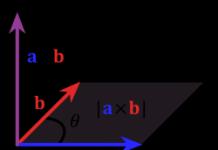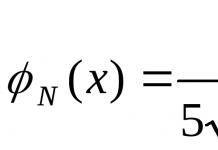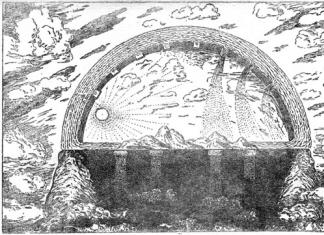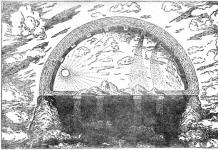Definition
A material point is a macroscopic body whose dimensions, shape, rotation and internal structure can be neglected when describing its motion.
The question of whether a given body can be considered as a material point depends not on the size of this body, but on the conditions of the problem being solved. For example, the radius of the Earth is much smaller than the distance from the Earth to the Sun, and its orbital motion can be well described as the movement of a material point with a mass equal to the mass of the Earth and located at its center. However, when considering the daily motion of the Earth around its own axis, replacing it with a material point does not make sense. The applicability of the material point model to a specific body depends not so much on the size of the body itself, but on the conditions of its motion. In particular, in accordance with the theorem on the motion of the center of mass of a system during translational motion, any solid can be considered a material point whose position coincides with the center of mass of the body.
Mass, position, speed and some others physical properties of a material point at any given moment in time completely determine its behavior.
The position of a material point in space is defined as the position of a geometric point. In classical mechanics, the mass of a material point is assumed to be constant in time and independent of any features of its movement and interaction with other bodies. In the axiomatic approach to the construction of classical mechanics, the following is accepted as one of the axioms:
Axiom
Material point - geometric point, which is associated with a scalar called mass: $(r,m)$, where $r$ is a vector in Euclidean space related to some Cartesian coordinate system. The mass is assumed to be constant, independent of the position of the point in space and time.
Mechanical energy can be stored by a material point only in the form kinetic energy its movement in space and (or) potential energy of interaction with the field. This automatically means that a material point is incapable of deformation (only an absolutely rigid body can be called a material point) and rotation around its own axis and changes in the direction of this axis in space. At the same time, the model of the motion of a body described by a material point, which consists in changing its distance from some instantaneous center of rotation and two Euler angles, which specify the direction of the line connecting this point to the center, is extremely widely used in many branches of mechanics.
The method of studying the laws of motion of real bodies by studying the motion of an ideal model - a material point - is fundamental in mechanics. Any macroscopic body can be represented as a collection of interacting material points g, with masses equal to the masses of its parts. The study of the movement of these parts comes down to the study of the movement of material points.
The limited application of the concept of a material point is visible from the following example: in a rarefied gas at high temperature the size of each molecule is very small compared to the typical distance between molecules. It would seem that they can be neglected and the molecule can be considered a material point. However, this is not always the case: vibrations and rotations of the molecule are an important reservoir. internal energy"molecule, the "capacity" of which is determined by the size of the molecule, its structure and chemical properties. To a good approximation, a monatomic molecule (inert gases, metal vapors, etc.) can sometimes be considered as a material point, but even in such molecules, at a sufficiently high temperature, excitation of electron shells is observed due to collisions of molecules, followed by emission.
Exercise 1
a) a car entering the garage;
b) a car on the Voronezh - Rostov highway?
a) a car entering a garage cannot be taken as a material point, since in these conditions the dimensions of the car are significant;
b) a car on the Voronezh-Rostov highway can be taken as a material point, since the size of the car is much smaller than the distance between cities.
Is it possible to take as a material point:
a) a boy who walks 1 km on his way home from school;
b) a boy doing exercises.
a) When a boy, returning from school, walks a distance of 1 km to his home, then the boy in this movement can be considered as a material point, because his size is small compared to the distance he covers.
b) when the same boy performs morning exercises, then he cannot be considered a material point.
In the world around us, everything is in constant motion. Movement in the general sense of the word means any changes occurring in nature. Most simple view movement is mechanical movement.
From the 7th grade physics course, you know that the mechanical motion of a body is the change in its position in space relative to other bodies that occurs over time.
When solving various scientific and practical problems related to the mechanical movement of bodies, you need to be able to describe this movement, i.e., determine the trajectory, speed, distance traveled, body position and some other characteristics of movement for any moment in time.
For example, running aircraft from Earth to another planet, scientists must first calculate where this planet is located relative to the Earth at the moment the apparatus lands on it. And to do this, it is necessary to find out how the direction and magnitude of the velocity of this planet change over time and along what trajectory it moves.
From a mathematics course, you know that the position of a point can be specified using a coordinate line or rectangular system coordinates (Fig. 1). But how to set the position of a body that has dimensions? After all, each point of this body will have its own coordinate.

Rice. 1. The position of a point can be specified using a coordinate line or a rectangular coordinate system
When describing the motion of a body that has dimensions, other questions arise. For example, what should be understood by the speed of a body if, while moving in space, it simultaneously rotates around its own axis? After all, the speed of different points of this body will be different both in magnitude and in direction. For example, during the daily rotation of the Earth, its diametrically opposite points move in opposite directions, and the closer to the axis the point is located, the lower its speed.
How can you set the coordinates, speed and other characteristics of the movement of a body that has dimensions? It turns out that in many cases, instead of the movement of a real body, one can consider the movement of a so-called material point, that is, a point that has the mass of this body.
For a material point, you can unambiguously determine the coordinates, speed, and other physical quantities, since it has no dimensions and cannot rotate around its own axis.
There are no material points in nature. A material point is a concept, the use of which simplifies the solution of many problems and at the same time allows one to obtain fairly accurate results.
- A material point is a concept introduced in mechanics to designate a body that is considered as a point having mass
Almost any body can be considered as a material point in cases where distances, passable points bodies are very large compared to its size.
For example, the Earth and other planets are considered material points when studying their movement around the Sun. In this case, differences in the movement of different points of any planet, caused by its daily rotation, do not affect the quantities describing the annual movement.

Planets are considered material points when studying their movement around the Sun
But when solving problems related to the daily rotation of planets (for example, when determining the time of sunrise in different places on the surface globe), it makes no sense to consider a planet a material point, since the result of the problem depends on the size of this planet and the speed of movement of points on its surface. So, for example, in the Vladimir time zone the sun will rise 1 hour later, in Irkutsk - 2 hours later, and in Moscow - 8 hours later than in Magadan.

It is legitimate to take an airplane as a material point if it is necessary, for example, to determine the average speed of its movement on the way from Moscow to Novosibirsk. But when calculating the air resistance force acting on a flying airplane, it cannot be considered a material point, since the resistance force depends on the shape and speed of the airplane.

An airplane flying from one city to another can be taken as a material point.
A body moving translationally 1 can be taken as a material point even if its dimensions are commensurate with the distances it travels. For example, a person standing on the step of a moving escalator moves forward (Fig. 2, a). At any given time, all points of the human body move equally. Therefore, if we want to describe the movement of a person (i.e., determine how his speed, path, etc. changes over time), then it is enough to consider the movement of only one of his points. In this case, solving the problem is significantly simplified.
When a body moves in a straight line, one coordinate axis is sufficient to determine its position.
For example, the position of a cart with a dropper (Fig. 2, b), moving along the table rectilinearly and translationally, at any time can be determined using a ruler located along the trajectory of movement (the cart with a dropper is taken as a material point). In this experiment, it is convenient to take the ruler as a body of reference, and its scale can serve as a coordinate axis. (Recall that the body of reference is the body relative to which the change in the position of other bodies in space is considered.) The position of the cart with the dropper will be determined relative to the zero division of the ruler.

Rice. 2. When a body moves forward, all its points move equally
But if it is necessary to determine, for example, the path that a cart has traveled in a certain period of time, or the speed of its movement, then in addition to a ruler, you will need a device for measuring time - a watch.
In this case, the role of such a device is played by a dropper, from which drops fall at regular intervals. By turning the tap, you can ensure that the drops fall at intervals of, for example, 1 second. By counting the number of intervals between the traces of drops on the ruler, you can determine the corresponding period of time.
From the above examples it is clear that in order to determine the position of a moving body at any time, the type of movement, the speed of the body and some other characteristics of movement, a reference body, an associated coordinate system (or one coordinate axis if the body is moving along a straight line) and a device for time measurements.
- The coordinate system, the reference body with which it is associated, and the device for measuring time form a reference system relative to which the movement of the body is considered
Of course, in many cases it is impossible to directly measure the coordinates of a moving body at any time. We do not have real possibility, for example, place a measuring tape and place observers with a watch along the many-kilometer path of a moving car, a liner sailing on the ocean, a flying airplane, a shell fired from an artillery gun, various celestial bodies, the movement of which we observe, etc.
Nevertheless, knowledge of the laws of physics makes it possible to determine the coordinates of bodies moving in various reference systems, in particular in the reference system associated with the Earth.
Questions
- What is a material point called?
- For what purpose is the concept of “material point” used?
- In what cases is a moving body usually considered as a material point?
- Give an example showing that the same body in one situation can be considered a material point, but not in another.
- In what case can the position of a moving body be specified using a single coordinate axis?
- What is a frame of reference?
Exercise 1
- Is it possible to consider a car as a material point when determining the path it has covered in 2 hours, moving with average speed, equal to 80 km/h; when overtaking another car?
- The plane flies from Moscow to Vladivostok. Can a controller observing its movement consider an airplane as a material point? passenger on this plane?
- When talking about the speed of a car, train, etc. Vehicle, the body of reference is usually not indicated. What is meant in this case by reference body?
- The boy stood on the ground and watched his little sister ride on the carousel. After the ride, the girl told her brother that he, the houses, and the trees were quickly rushing past her. The boy began to claim that he, along with the houses and trees, was motionless, but his sister was moving. Relative to what reference bodies did the girl and boy consider the movement? Explain who is right in the dispute.
- Relative to what body of reference is motion considered when they say: a) the wind speed is 5 m/s; b) the log floats along the river, so its speed is zero; c) the speed of a tree floating along a river is equal to the speed of water flow in the river; d) any point on the wheel of a moving bicycle describes a circle; e) the sun rises in the east in the morning, moves across the sky during the day, and sets in the west in the evening?
1 Translational motion is the movement of a body in which a straight line connecting any two points of this body moves, remaining at all times parallel to its original direction. Translational motion can be either rectilinear or curvilinear motion. For example, the cabin of a Ferris wheel moves forward.
Material point. Reference system.
The mechanical movement of a body is the change in its position relative to other bodies over time.
Almost all physical phenomena are accompanied by the movement of bodies. In physics there is a special section that studies motion - this is Mechanics.
The word “mechanics” comes from the Greek “mechane” - machine, device.
When various machines and mechanisms operate, their parts move: levers, ropes, wheels,... Mechanics also includes finding the conditions under which a body is at rest - the conditions of equilibrium of bodies. These questions play huge role in construction business. Not only material bodies can move, but also a sunbeam, a shadow, light signals, and radio signals.
To study movement, you must be able to describe movement. We are not interested in how this movement arose, we are interested in the process itself. The branch of mechanics that studies motion without investigating the cause that causes it is called kinematics.
The movement of each body can be considered in relation to different bodies, and relative to them this body will perform various movements: a suitcase lying in a carriage on the rack of a moving train is at rest relative to the carriage, and moving relative to the Earth. Balloon carried away by the wind - relative to the Earth - moves, and relative to the air - is at rest. An airplane flying in a squadron is at rest relative to other airplanes in the formation, but relative to the Earth it moves at high speed.
Therefore, any movement, as well as the rest of the body, is relative.
When answering the question whether a body is moving or at rest, we must indicate in relation to what we are considering the movement.
The body relative to which this movement is considered is called the body of reference.
A coordinate system and a device for measuring time are associated with the reference body. This entire set forms reference system .
What does it mean to describe movement? This means that you need to determine:
1. trajectory, 2. speed, 3. path, 4. body position.
The situation is very simple with a point. From a mathematics course we know that the position of a point can be specified using coordinates. What if we have a body that has size? Each point will have its own coordinates. In many cases, when considering the movement of a body, the body can be taken as a material point, or a point that has the mass of this body. And for a point there is only one way to determine the coordinates.
So, a material point is an abstract concept that is introduced to simplify problem solving.
Condition under which a body can be taken as a material point:
Often a body can be taken as a material point and, provided that its dimensions are comparable to the distance traveled, when at any moment of time all points move the same way. This type of movement is called translational.
Sign forward movement is the condition that a straight line mentally drawn through any two points of the body remains parallel to itself.
Example: a person moves on an escalator, a needle in a sewing machine, a piston in an internal combustion engine, a car body when driving on a straight road.
Different movements differ in the type of trajectory.
If the trajectory straight line- That linear motion, if the trajectory is a curved line, then the movement is curvilinear.
Moving.
Path and movement: what's the difference?

S = AB + BC + CD
Displacement is a vector (or directed line segment) connecting an initial position to its subsequent position.
Displacement is a vector quantity, which means it is characterized by two quantities: a numerical value or magnitude and direction.
It is designated – S, and is measured in meters (km, cm, mm).
If you know the displacement vector, you can unambiguously determine the position of the body.

Vectors and actions with vectors.
VECTOR DEFINITION
Vector called a directed segment, that is, a segment that has a beginning (also called the point of application of the vector) and an end.

VECTOR MODULE
The length of a directed segment representing a vector is called length, or module, vector. The length of the vector is denoted by .
NULL VECTOR
Null vector() - a vector whose beginning and end coincide; its modulus is 0 and its direction is uncertain.
COORDINATE REPRESENTATION
Let a Cartesian coordinate system XOY be specified on the plane.

Then the vector can be specified by two numbers:
https://pandia.ru/text/78/050/images/image010_22.gif" width="84" height="25 src=">
These numbers https://pandia.ru/text/78/050/images/image012_18.gif" width="20" height="25 src="> in geometry are called vector coordinates, and in physics – vector projections to the corresponding coordinate axes.
To find the projection of a vector, you need to: drop perpendiculars from the beginning and end of the vector on the coordinate axes.
Then the projection will be the length of the segment enclosed between the perpendiculars.
The projection can take on both positive and negative meanings.
If the projection turns out with a “-“ sign, then the vector is directed towards the opposite side axis on which it was designed.
With this definition of its vector module, A direction is given by angle a, which is uniquely determined by the relations:
https://pandia.ru/text/78/050/images/image015_13.gif" width="75" height="48 src=">
COLLINEAR VECTORS
D) chess piece
E) chandelier in the room,
G) submarine,
Y) plane on the runway.
8. Do we pay for the journey or transportation when traveling in a taxi?
9. The boat traveled along the lake in a northeast direction for 2 km, and then in a northerly direction for another 1 km. Find geometric construction movement and its modulus.
Material point
Material point(particle) - the simplest physical model in mechanics - an ideal body whose dimensions are equal to zero; the dimensions of the body can also be considered infinitesimal compared to other sizes or distances within the assumptions of the problem under study. The position of a material point in space is defined as the position of a geometric point.
In practice, a material point is understood as a body with mass, the size and shape of which can be neglected when solving this problem.
When a body moves in a straight line, one coordinate axis is sufficient to determine its position.
Peculiarities
The mass, position and speed of a material point at any given moment in time completely determine its behavior and physical properties.
Consequences
Mechanical energy can be stored by a material point only in the form of the kinetic energy of its movement in space, and (or) the potential energy of interaction with the field. This automatically means that a material point is incapable of deformation (only an absolutely rigid body can be called a material point) and rotation around its own axis and changes in the direction of this axis in space. At the same time, the model of the motion of a body described by a material point, which consists in changing its distance from some instantaneous center of rotation and two Euler angles, which specify the direction of the line connecting this point with the center, is extremely widely used in many branches of mechanics.
Restrictions
The limited application of the concept of a material point is clear from this example: in a rarefied gas at high temperature, the size of each molecule is very small compared to the typical distance between molecules. It would seem that they can be neglected and the molecule can be considered a material point. However, this is not always the case: vibrations and rotations of a molecule are an important reservoir of the “internal energy” of the molecule, the “capacity” of which is determined by the size of the molecule, its structure and chemical properties. To a good approximation, a monatomic molecule (inert gases, metal vapors, etc.) can sometimes be considered as a material point, but even in such molecules, at a sufficiently high temperature, excitation of electron shells is observed due to collisions of molecules, followed by emission.
Notes
Wikimedia Foundation.
- 2010.
- Mechanical movement
Absolutely solid body
See what a “material point” is in other dictionaries:- a point with mass. In mechanics, the concept of a material point is used in cases where the size and shape of a body do not play a role in the study of its motion, and only mass is important. Almost any body can be considered as a material point if... ... Big Encyclopedic Dictionary
See what a “material point” is in other dictionaries:- a concept introduced in mechanics to designate an object, which is considered as a point with mass. The position of the M. t. in law is defined as the position of the geom. points, which greatly simplifies the solution of mechanics problems. Practically, the body can be considered... ... Physical encyclopedia
material point- A point with mass. [Collection of recommended terms. Issue 102. Theoretical mechanics. Academy of Sciences of the USSR. Committee of Scientific and Technical Terminology. 1984] Topics theoretical mechanics EN particle DE materialle Punkt FR point matériel … Technical Translator's Guide
See what a “material point” is in other dictionaries: Modern encyclopedia
See what a “material point” is in other dictionaries:- In mechanics: an infinitesimal body. Dictionary foreign words, included in the Russian language. Chudinov A.N., 1910 ... Dictionary of foreign words of the Russian language
Material point- MATERIAL POINT, a concept introduced in mechanics to designate a body whose size and shape can be neglected. The position of a material point in space is defined as the position of a geometric point. The body can be considered material... ... Illustrated Encyclopedic Dictionary
material point- a concept introduced in mechanics for an object of infinitesimal size that has mass. The position of a material point in space is defined as the position of a geometric point, which simplifies the solution of mechanics problems. Almost any body can... ... encyclopedic Dictionary
Material point- a geometric point with mass; material point is an abstract image of a material body that has mass and has no dimensions... The beginnings of modern natural science
material point- materialusis taškas statusas T sritis fizika atitikmenys: engl. mass point; material point vok. Massenpunkt, m; materieller Punkt, m rus. material point, f; point mass, f pranc. point mass, m; point matériel, m … Fizikos terminų žodynas
material point- A point with mass... Polytechnic terminological explanatory dictionary
Books
- Set of tables. Physics. 9th grade (20 tables), . Educational album of 20 sheets. Material point. Coordinates of a moving body. Acceleration. Newton's laws. Law universal gravity. Rectilinear and curvilinear movement. Body movement along...
See what a “material point” is in other dictionaries:– a model concept (abstraction) of classical mechanics, denoting a body of vanishingly small dimensions, but having a certain mass.
On the one hand, a material point is the simplest object of mechanics, since its position in space is determined by only three numbers. For example, three Cartesian coordinates of the point in space in which our material point is located.
On the other hand, a material point is the main supporting object of mechanics, since it is for it that the basic laws of mechanics are formulated. All other objects of mechanics - material bodies and environments - can be represented in the form of one or another set of material points. For example, any body can be “cut” into small parts and each of them can be taken as a material point with the corresponding mass.
When it is possible to “replace” a real body with a material point when posing a problem about the motion of a body, it depends on the questions that must be answered by the solution of the formulated problem.
Various approaches to the question of using the material point model are possible.
One of them is empirical in nature. It is believed that the material point model is applicable when the sizes of moving bodies are negligible compared to the magnitude of the relative movements of these bodies. As an illustration we can cite solar system. If we assume that the Sun is a stationary material point and assume that it acts on another material point-planet according to the law of universal gravitation, then the problem of the movement of a point-planet has a known solution. Among the possible trajectories of a point’s motion, there are also those on which Kepler’s laws, empirically established for the planets of the solar system, are satisfied.
Thus, when describing the orbital motions of planets, the material point model is quite satisfactory. (However, the construction mathematical model such phenomena as solar and lunar eclipses requires taking into account the actual sizes of the Sun, Earth and Moon, although these phenomena are obviously associated with orbital movements.)
The ratio of the diameter of the Sun to the diameter of the orbit of the nearest planet - Mercury - is ~ 1·10 -2, and the ratio of the diameters of the planets closest to the Sun to the diameters of their orbits is ~ 1 ÷ 2·10 -4. Can these numbers serve as a formal criterion for neglecting the size of a body in other problems and, therefore, for the acceptability of the point model? Practice shows that no.
For example, a small bullet size l= 1 ÷ 2 cm distance flies L= 1 ÷ 2 km, i.e. ratio, however, the flight trajectory (and range) significantly depends not only on the mass of the bullet, but also on its shape, and on whether it rotates. Therefore, even a small bullet, strictly speaking, cannot be considered a material point. If in problems of external ballistics the thrown body is often considered a material point, then this is accompanied by a number of additional conditions, which, as a rule, empirically take into account the real characteristics of the body.
If we turn to astronautics, then when spacecraft(SC) is launched into a working orbit; in further calculations of its flight trajectory, it is considered a material point, since no changes in the shape of the spacecraft have any noticeable effect on the trajectory. Only sometimes, when making trajectory corrections, does it become necessary to ensure precise orientation of jet engines in space.
When the descent compartment approaches the Earth’s surface at a distance of ~100 km, it immediately “turns” into a body, since the “side” it enters the dense layers of the atmosphere determines whether the compartment will reach desired point Astronaut lands and returned materials.
The model of a material point turned out to be practically unacceptable for describing the movements of such physical objects of the microworld as elementary particles, atomic nuclei, electron, etc.
Another approach to the question of using the material point model is rational. According to the law of change in the momentum of a system, applied to an individual body, the center of mass C of the body has the same acceleration as some (let’s call it equivalent) material point, which is acted upon by the same forces as on the body, i.e.
Generally speaking, the resulting force can be represented as a sum , where depends only on and (radius vector and speed of point C), and - and on angular velocity body and its orientation.
If F 2 = 0, then the above relation turns into the equation of motion of an equivalent material point.
In this case, they say that the movement of the center of mass of the body does not depend on the rotational motion of the body. Thus, the possibility of using a material point model receives a rigorous mathematical (and not just empirical) justification.
Naturally, in practice the condition F 2 = 0 is performed rarely and usually F 2 No. 0, however, it may turn out that F 2 is in some ways small compared to F 1 . Then we can say that the model of an equivalent material point is some approximation in describing the motion of a body. An estimate of the accuracy of such an approximation can be obtained mathematically, and if this estimate turns out to be acceptable for the “consumer,” then replacing the body with an equivalent material point is acceptable, otherwise such a replacement will lead to significant errors.
This can also occur when the body moves translationally and, from the point of view of kinematics, it can be “replaced” by some equivalent point.
Naturally, the model of a material point is not suitable for answering questions such as “why does the Moon face the Earth with only one side?” Similar phenomena are associated with rotational movement bodies.
Vitaly Samsonov


























